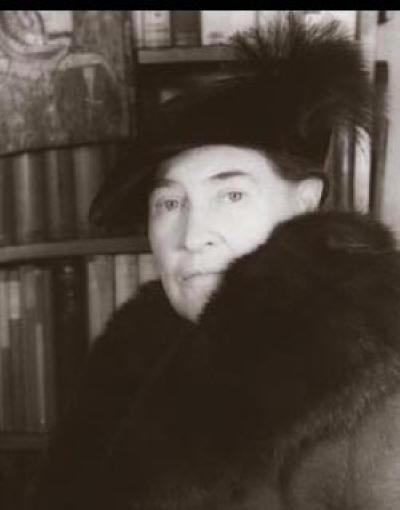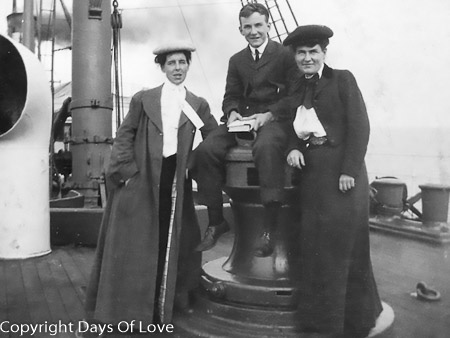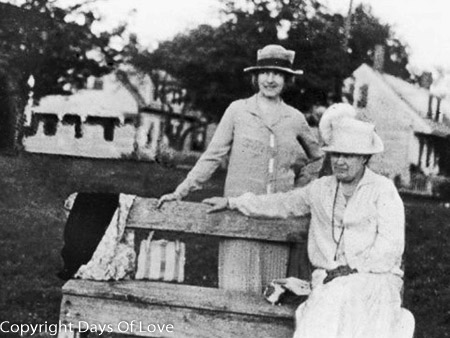

Partner Edith Lewis, buried together
Queer Places:
Gore, US-50, Virginia, Stati Uniti
Willow Shade, Winchester, Virginia 22601, Stati Uniti
413 N Webster St, Red Cloud, NE 68970, Stati Uniti
University of Nebraska-Lincoln, 1400 R St, Lincoln, NE 68588, Stati Uniti
1180 Murray Hill Ave, Pittsburgh, PA 15217, USA
60 Washington Square S, New York, NY 10012, Stati Uniti
82 Washington Pl, New York, NY 10011, USA
5 Bank St, New York, NY 10014, Stati Uniti
Shattuck Inn Resort, 53 Dublin Rd, Jaffrey, NH 03452, Stati Uniti
120 Whistle Rd, Grand Manan, NB E5G 1B3, Canada
The Grosvenor Hotel, 35 5th Ave, New York, NY 10003, Stati Uniti
570 E 63rd St, New York, NY 10065, Stati Uniti
MacDowell Colony, 100 High St, Peterborough, NH 03458
Old Burying Ground, 23 Knight Rd, Jaffrey, NH 03452, Stati Uniti
 Willa Sibert Cather (December 7, 1873[2]
– April 24, 1947[3])
was an American writer who achieved recognition for her novels of
frontier
life on the
Great Plains, including
O
Pioneers! (1913),
The Song of the Lark (1915), and
My
Ántonia (1918). In 1923 she was awarded the
Pulitzer Prize for
One of Ours (1922), a novel set during
World War I. During this period, unmarried women often coupled together as
long-term companions, sharing their lives, their homes, their finances,
and quite often their beds. The phenomenon was so common, in fact, that
such arrangements were known by the colloquial term “Boston marriage,” a
reference to the 1886 novel The Bostonians, by
Henry James. Some of the most
influential women of this era lived in such relationships.
Jane Addams, founder of the
American settlement house movement;
Emily Blackwell, one of the
first female medical doctors in the United States and a pioneer in
providing medical training to other women;
M. Carey Thomas, president of
Bryn Mawr College; Sara
Josephine Baker, an early advocate for childhood public health; and
author Willa Cather are but a few
examples. Surviving documents make it clear that the women involved
understood these relationships to be serious, emotional unions. They refer
to their partners as “My Ever Dear,” “devoted companion,” “lover,”
“dearest,” and often describe lifelong devotion, as when reformer Jane
Addams wrote to Mary Rozet Smith, her partner of more than thirty years,
“I miss you dreadfully and am yours ’til death.”
Willa Sibert Cather (December 7, 1873[2]
– April 24, 1947[3])
was an American writer who achieved recognition for her novels of
frontier
life on the
Great Plains, including
O
Pioneers! (1913),
The Song of the Lark (1915), and
My
Ántonia (1918). In 1923 she was awarded the
Pulitzer Prize for
One of Ours (1922), a novel set during
World War I. During this period, unmarried women often coupled together as
long-term companions, sharing their lives, their homes, their finances,
and quite often their beds. The phenomenon was so common, in fact, that
such arrangements were known by the colloquial term “Boston marriage,” a
reference to the 1886 novel The Bostonians, by
Henry James. Some of the most
influential women of this era lived in such relationships.
Jane Addams, founder of the
American settlement house movement;
Emily Blackwell, one of the
first female medical doctors in the United States and a pioneer in
providing medical training to other women;
M. Carey Thomas, president of
Bryn Mawr College; Sara
Josephine Baker, an early advocate for childhood public health; and
author Willa Cather are but a few
examples. Surviving documents make it clear that the women involved
understood these relationships to be serious, emotional unions. They refer
to their partners as “My Ever Dear,” “devoted companion,” “lover,”
“dearest,” and often describe lifelong devotion, as when reformer Jane
Addams wrote to Mary Rozet Smith, her partner of more than thirty years,
“I miss you dreadfully and am yours ’til death.”
Socially Cather had many strong friendships with women including opera singer Olive Fremstad, socialite Isabelle McClung, pianist Yaltah Menuhin, and scholar Louise Pound. Beside Isabelle McClung and Edith Lewis, Willa Cather had close relationships with a number of other women, including the writers Elizabeth Shepley Sargent, Dorothy Canfield Fisher, Zoe Atkins, and Sarah Orne Jewett, who was Cather's literary mentor.
Cather grew up in Virginia and Nebraska, and graduated from the University of Nebraska–Lincoln. She lived and worked in Pittsburgh for ten years,[4] supporting herself as a magazine editor and high school English teacher. At the age of 33 she moved to New York City, her primary home for the rest of her life, though she also traveled widely and spent considerable time at her summer residence on Grand Manan Island, New Brunswick.


Willow Shade, Winchester, VA
La Fonda on the Plaza, Santa Fe, NM
The Grosvenor Hotel, 35 5th Ave
82 Washington Pl
As a student at the University of Nebraska in the early 1890s, Cather sometimes used the masculine nickname "William" and wore masculine clothing.[24] A photograph in the University of Nebraska archives depicts Cather dressed like a young man and with "her hair shingled, at a time when females wore their hair fashionably long."[8]:38
Cather's sexual identity remains a point of contention among scholars. While many argue for Cather as a lesbian and interpret her work through a lens of queer theory,[25] a highly vocal contingent of Cather scholars adamantly oppose such considerations. For example, scholar Janet Sharistanian has written, "Cather did not label herself a lesbian nor would she wish us to do so, and we do not know whether her relationships with women were sexual. In any case, it is anachronistic to assume that if Cather's historical context had been different, she would have chosen to write overtly about homoerotic love."[26]
Throughout Cather's adult life, her most significant friendships were with women. These included her college friend Louise Pound; the Pittsburgh socialite Isabelle McClung, with whom Cather traveled to Europe and at whose Toronto home she stayed for prolonged visits;[27] the opera singer Olive Fremstad; the pianist Yaltah Menuhin;[28] and most notably, the editor Edith Lewis, with whom Cather lived the last 39 years of her life.
Cather's relationship with Lewis began in the early 1900s. The two women lived together in a series of apartments in New York City from 1908 until the writer's death in 1947. From 1913 to 1927, Cather and Lewis lived at No. 5 Bank Street in Greenwich Village.
Zoe Akins wrote stories and essays for a local literary magazine and in 1909 moved to New York, determined to find her way to the stage. To pay her bills, she wrote for several magazines, becoming in the process a protégé of Willa Cather, then editor of McClure's. Cather helped Akins publish her first collection of verse, Interpretations (1911), and they remained lifelong friends.
Olive Fremstad was a celebrated Swedish-American opera diva who sang in both the mezzo-soprano and soprano ranges.[1] She wed twice, with both marriages ending in divorce, and also lived for some time in a couple with her secretary, Mary Watkins Cushing. Her relationship with Cushing was fictionalized in the novel Of Lena Geyer, by Marcia Davenport. Fremstad was the model for Thea Kronborg, the heroine of Willa Cather's novel The Song of the Lark, written in 1915.[4]
Cather and Lewis moved from No. 5 Bank Street when the apartment was scheduled for demolition during the construction of the Broadway – Seventh Avenue New York City Subway line (now the 1, 2, and 3 trains).[29] Cather selected Lewis as the literary trustee for her estate.[30]
The editors of Poetry, Harriet Monroe and Alice Corbin Henderson included in their 1917 selection for The New Poetry: An Anthology poems by Willa Sibert Cather. According to Adrienne Munich and Melissa Bradshaw, authors of Amy Lowell, American Modern, what connects these poets is their appartenance to the queer sisterhood.
Beginning in 1922, Cather spent summers on Grand Manan Island, in New Brunswick, where she bought a cottage in Whale Cove, on the Bay of Fundy and where her penultimate short story, "Before Breakfast," is set.[32] It was the only house she ever owned.[2]:23 She valued the seclusion of the island, and did not mind that her cottage had neither indoor plumbing nor electricity. Anyone wishing to reach her could do so by telegraph or mail.[2]:415 She stopped going to Grand Manan Island when Canada entered World War II (1939), since travel was more difficult, tourist amenities were scarcer, and a favourite island doctor had died. Cather was experiencing a long recuperation from gall bladder surgery.[2]:496
A resolutely private person, Cather had destroyed many old drafts, personal papers, and letters. Her will restricted the ability of scholars to quote from the personal papers that remain. However, in April 2013, The Selected Letters of Willa Cather—a collection of 566 letters Cather wrote to friends, family, and literary acquaintances such as Thornton Wilder and F. Scott Fitzgerald—was published, two years after the death of Cather's nephew and second literary executor, Charles Cather. Willa Cather's correspondence revealed complexity of her character and inner world.[33] The letters do not disclose any intimate details about Cather's personal life, but they do "make clear that [her] primary emotional attachments were to women."[34]
Cather was buried in the Old Burying Ground, behind the Jaffrey Center Meeting House in Jaffrey, New Hampshire.[53] Her grave site, which she shares with Edith Lewis, is at the southwest corner of the graveyard. She had first visited Jaffrey in 1917 when she joined Isabelle McClung and her husband, violinist Jan Hambourg,[54] staying at the Shattuck Inn, where she came late in life for the seclusion necessary for her writing.
My published books: